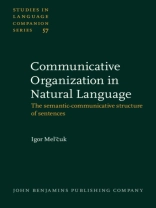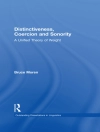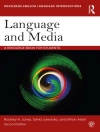The book defines the concept of Semantic-Communicative Structure [= Sem-Comm S]-a formal object that is imposed on the starting Semantic Structure [= Sem S] of a sentence (under text synthesis) in order to turn the selected meaning into a linguistic message. The Sem-Comm S is a system of eight logically independent oppositions: 1. Thematicity (Rheme vs. Theme), 2. Givenness (Given vs. Old), 3. Focalization (Focalized vs. Non-Focalized), 4. Perspective (Foregrounded vs. Backgrounded), 5. Emphasis (Emphasized vs. Non-Emphasized), 6. Presupposedness (Presupposed vs. Non-Presupposed), 7. Unitariness (Unitary vs. Articulated), 8. Locutionality (Communicated vs. Signaled). The values of these oppositions mark particular subnetworks of the starting Sem S and thus allow for the distinction between sentences such as (a) A man killed a dog vs. The dog was killed by a man, (b) John washed the window vs. It was John who washed the window or (c) It hurts! vs. Ouch! The proposed Sem-Comm-oppositions are conceived as an attempt at sharpening the well-known notions of Topic ~ Comment, Focus, etc. Possible linguistic strategies for expressing the values of the Sem-Comm-oppositions in different languages are discussed at some length, with linguistic illustrations.
Mel’cuk Igor Mel’cuk
Communicative Organization in Natural Language [PDF ebook]
The semantic-communicative structure of sentences
Communicative Organization in Natural Language [PDF ebook]
The semantic-communicative structure of sentences
购买此电子书可免费获赠一本!
语言 英语 ● 格式 PDF ● 网页 405 ● ISBN 9789027294838 ● 出版者 John Benjamins Publishing Company ● 发布时间 2001 ● 下载 3 时 ● 货币 EUR ● ID 4225155 ● 复制保护 Adobe DRM
需要具备DRM功能的电子书阅读器












